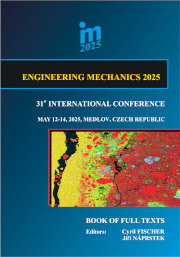Proceedings Vol. 31 (2025)

ENGINEERING MECHANICS 2025
May 12 – 14, 2025, Medlov, Czech Republic
All papers were reviewed by members of the scientific committee.
ISBN 978-80-86246-99-4 (electronic)
ISSN 1805-8248 (printed)
ISSN 1805-8256 (electronic)
scientific committee — home
Chapter 7: Mechatronics
The tuning method presented in the article belongs to the group of frequency - response methods. Only simple explicit formulas are used in a single tuning cycle. The input quantities are r0 – P - controller gain and two arbitrary frequencies out of three (f1, f2, f0), where f1 is the lower and f2 is the upper frequency of the P - controller interval (3 or 1 dB) and f0 is the geometric mean (scale, norm) frequency. The calculated quantities are r-1, r1, where r-1 is I - controller gain and r1 is D - controller gain. The formulas used provide accurate output values, unlike the relationships valid for asymptotic estimates. Asymptotic estimates are very inaccurate for relatively narrow (f2 - f1) intervals of the P - controller. The published method is valid for an ideal PID controller. Using a similar procedure, analogous relations can be derived even if a simple filter is used in the D - controller branch.
Sewer pipes mapping is a task of creating the virtual model of pipe system using either external means or internal sensor of a robot moving through the pipe. The paper introduces the concept of such mapping algorithm based on fusion of data given by internal sensors on multi-segment robot both on the segments themselves and the inter-segment sensors. The fusion is based on Extended Kalman Filter and is shown for simplified 2D model. The simulation results for simplified model show good robustness against the noise.
This study investigates the optimization of obstacle-aided locomotion in snake-like robots through a simulation-in-the-loop framework. A dynamic model of the robot is developed in CoppeliaSim to evaluate contact forces interactions during navigation in environments with varying obstacle densities. These interactions are used to optimize the robot’s motion trajectory with minimal actuator energy while penalizing contact forces. The robot’s motion is parametrized by a set of serpentine gait parameters, optimized using Particle Swarm Optimization to exploit beneficial obstacle contacts. Results reveal a trade-off between obstacle utilization and energy efficiency, demonstrating the potential of obstacle-aware trajectory planning for enhanced locomotion performance.
This paper explores the application of Proximal Policy Optimization (PPO) for achieving stable bipedal locomotion in autonomous robots. Unlike traditional model-based approaches, PPO leverages reinforcement learning to develop adaptive gait patterns that respond to environmental changes in real time.
Copyright © 2025 Institute of Theoretical and Applied Mechanics, Czech Academy of Sciences, Prague
All contributions are published under the Creative Commons Attribution 4.0 International License (CC BY 4.0). The copyright remains with the authors. The texts are publicly accessible, and any reuse must include appropriate credit to the original source as required by the license.
